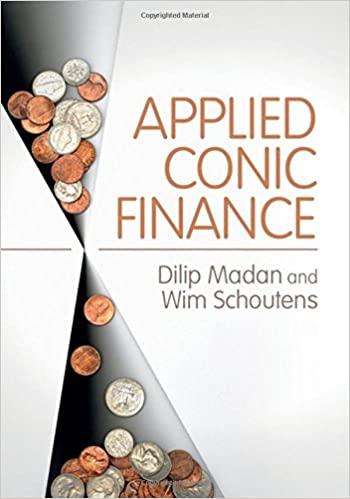Question
5. Suppose Yon Sun Corporations free cash flow during the just-ended year (t = 0) was $100 million, and FCF is expected to grow at
5. Suppose Yon Sun Corporations free cash flow during the just-ended year (t = 0) was $100 million, and FCF is expected to grow at a constant rate of 5% in the future. If the weighted average cost of capital is 15%, what is the firms value of operations, in millions?
6. Zhdanov Inc. forecasts that its free cash flow in the coming year, i.e., at t = 1, will be - $10 million, but its FCF at t = 2 will be $20 million. After Year 2, FCF is expected to grow at a constant rate of 4% forever. If the weighted average cost of capital is 14%, what is the firms value of operations, in millions?
7. A company forecasts the free cash flows (in millions) shown below. The weighted average cost of capital is 13%, and the FCFs are expected to continue growing at a 5% rate after Year 3. Assuming that the ROIC is expected to remain constant in Year 3 and beyond, what is the Year 0 value of operations, in millions?
Year: 1 2 3
Free cash flow: -$15 $10 $40
8. Based on the corporate valuation model, Bernile Inc.s value of operations is $750 million. Its balance sheet shows $50 million of short-term investments that are unrelated to operations, $100 million of accounts payable, $100 million of notes payable, $200 million of long-term debt, $40 million of common stock (par plus paid-in-capital), and $160 million of retained earnings. What is the best estimate for the firms value of equity, in millions?
9. Based on the corporate valuation model, the value of a companys operations is $900 million. Its balance sheet shows $70 million in accounts receivable, $50 million in inventory, $30 million in short-term investments that are unrelated to operations, $20 million in accounts payable, $110 million in notes payable, $90 million in long-term debt, $20 million in preferred stock, $140 million in retained earnings, and $280 million in total common equity. If the company has 25 million shares of stock outstanding, what is the best estimate of the stocks price per share?
10.
Free cash flow to equity (FCFE) is calculated as
a) Net Income + Depreciation Expense Capital Expenditures Change in
Working Capital Principal Debt Repayments + New Debt Issues.
b) EBIT (1 T) + Depreciation Expense Capital Expenditures Change
in Working Capital Change in Other Assets.
c) Net Income + Depreciation Expense Capital Expenditures + Change
in Working Capital Principal Debt Repayments - New Debt Issues.
d) Net Income - Depreciation Expense + Capital Expenditures Change in
Working Capital Principal Debt Repayments + New Debt Issues.
e) EBIT (1 T) + Depreciation Expense + Capital Expenditures + Change
in Working Capital Change in Other Assets.
Operating Free cash flow (FCFF) is calculated as
a) Net Income + Depreciation Expense Capital Expenditures Change in
Working Capital Principal Debt Repayments + New Debt Issues.
b) EBIT (1 T) + Depreciation Expense Capital Expenditures Change
in Working Capital Change in Other Assets.
c) Net Income + Depreciation Expense Capital Expenditures + Change in
Working Capital Principal Debt Repayments - New Debt Issues.
d) Net Income - Depreciation Expense + Capital Expenditures Change in
Working Capital Principal Debt Repayments + New Debt Issues.
e) EBIT (1 T) + Depreciation Expense + Capital Expenditures + Change
in Working Capital Change in Other Assets.
11.
a) Net Income + Depreciation Expense Capital Expenditures Change in
Working Capital Principal Debt Repayments + New Debt Issues.
b) EBIT (1 T) + Depreciation Expense Capital Expenditures Change
in Working Capital Change in Other Assets.
c) Net Income + Depreciation Expense Capital Expenditures + Change in
Working Capital Principal Debt Repayments - New Debt Issues.
d) Net Income - Depreciation Expense + Capital Expenditures Change in
Working Capital Principal Debt Repayments + New Debt Issues.
e) EBIT (1 T) + Depreciation Expense + Capital Expenditures + Change
in Working Capital Change in Other Assets.
12. ___________________versus a discount rate of ____________________for an FCFE model.
The most appropriate discount rate to use when applying a FCFF valuation model is the
13. Zero had a FCFF of $4.5M last year and has 2.25M shares outstanding. Zero's required return on equity is 12% and WACC is 10%. If FCFF is expected to grow at 8% forever, the intrinsic value of Zero's shares are ____________. The company has zero debt and no non-operating assets.
14. Boaters World is expected to have per share FCFE in year 1 of $1.65, per share FCFF in year 2 of $1.97, and per share FCFF in year 3 of $2.54. After year 3, per share FCFE is expected to grow at the rate of 8% per year. An appropriate discount rate for the stock is 11%. The stock should be worth _______ today. The company has zero debt and no non-operating assets.
15. The growth in per share FCFE of SYNK, Inc. is expected to be 8%/year for the next two years, followed by a growth rate of 4%/year for three years; after this five year period, the growth in per share FCFE is expected to be 3%/year, indefinitely. The required rate of return on SYNC, Inc. is 11%. Last year's per share FCFE was $2.75. What should the stock sell for today?
Step by Step Solution
There are 3 Steps involved in it
Step: 1

Get Instant Access to Expert-Tailored Solutions
See step-by-step solutions with expert insights and AI powered tools for academic success
Step: 2

Step: 3

Ace Your Homework with AI
Get the answers you need in no time with our AI-driven, step-by-step assistance
Get Started


